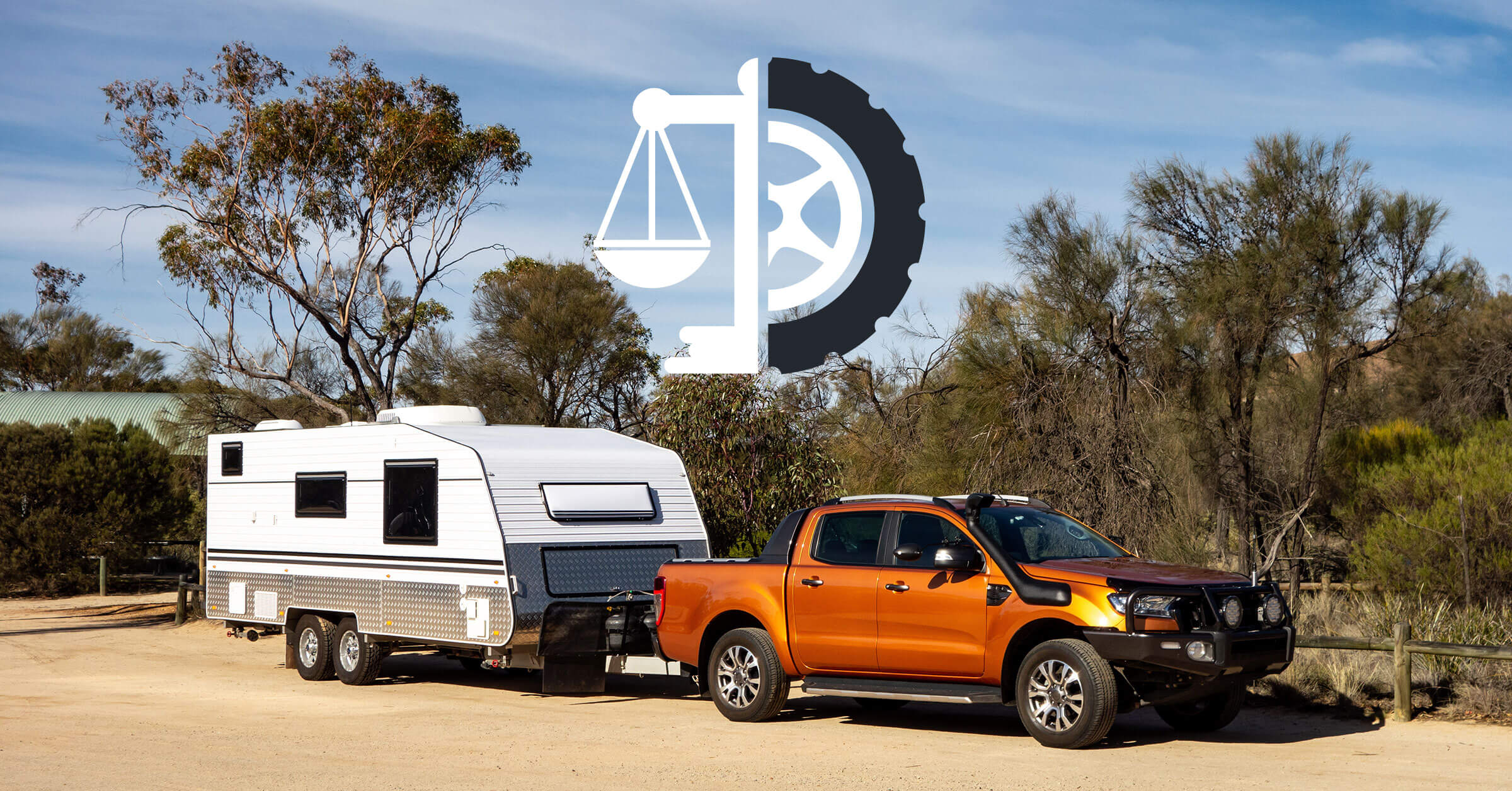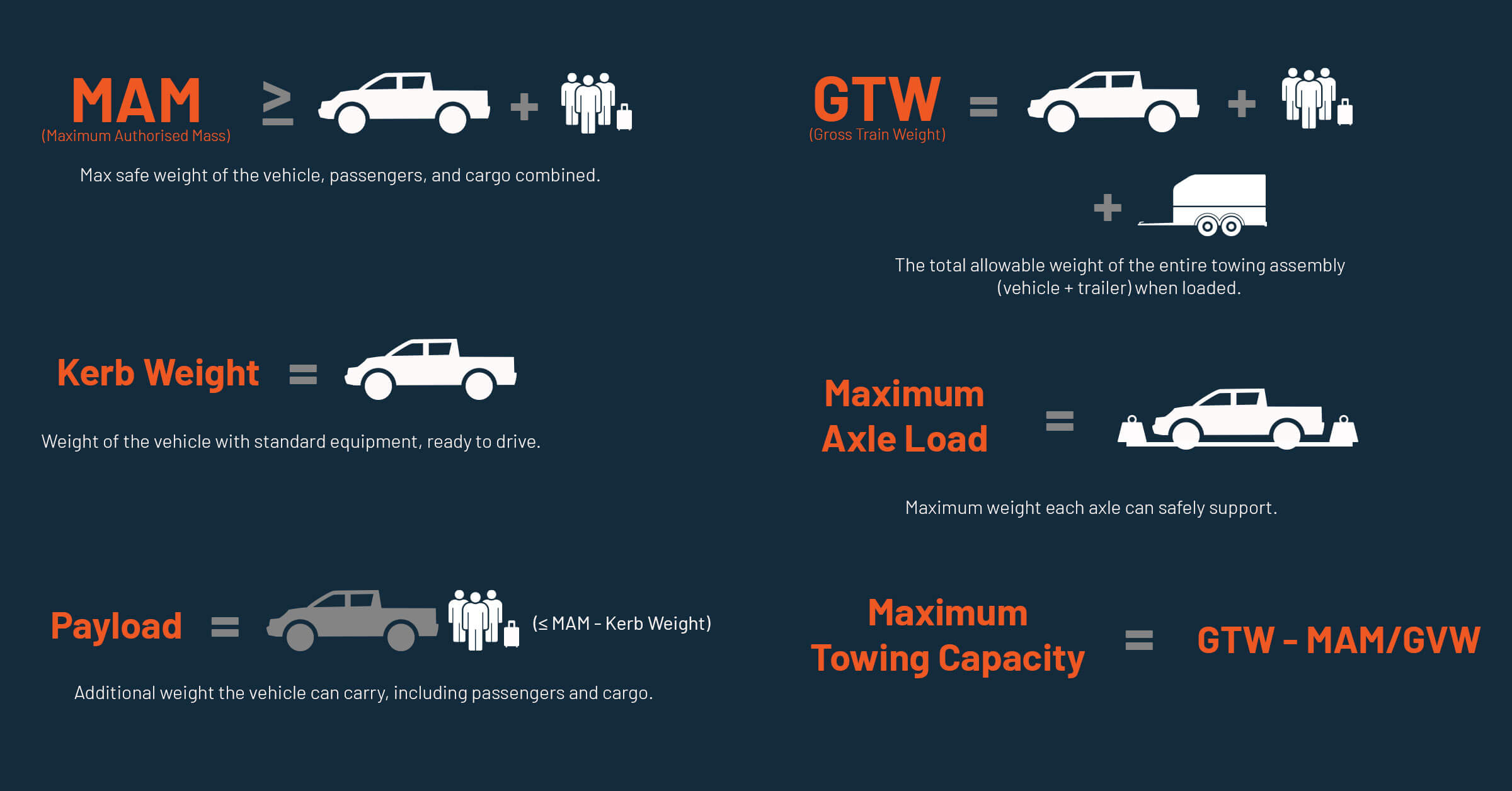
Vehicle Weights and Towing Weight Limits
Whether you're hauling cargo, towing a trailer, or hitting the road with your caravan, understanding and adhering to your vehicle's weight limits is crucial for safety. The terminology surrounding vehicle weights and towing weight limits can be confusing, but this guide simplifies these terms—MAM, GTW, Kerb Weight, Payload, and more. We'll explain what they mean, why they matter for safe towing, and where to find these numbers on your vehicle or trailer
Gross Vehicle Weight (GVW) or Maximum Authorised Mass (MAM)
It's crucial to be aware that every car has a limit to how much weight it can handle. This limit is called the maximum authorized mass (MAM) or gross vehicle weight (GVW) and is set by the manufacture to ensure that you do not load your car with too much weight that could affect its safety. MAM takes into account the vehicle's own weight (kerb weight) as well as the combined weight of everyone in the car, a full tank of fuel, and other items that add weight to the vehicle (payload). You will find this MAM/GVW figure on the vehicle's weight placard (in the driver's door opening) or in the owner's manual.
Your driver's license category also determines what weight you can tow. In the UK, a standard category B license allows you to drive a vehicle to 3,500 kg MAM (or 7,500 kg if you got your license before 1996) and tow a trailer to 750 kg. For towing heavier trailers, additional entitlements and possibly a separate test may be required.
Check the official government guidance for more details.
Kerb Weight and Payload
Kerb weight, also known as curb weight (American English), is your vehicle's weight straight off the factory floor. It's the weight of the car itself, with all its fluids (oil, coolant, etc.) but bone dry of everything else. Manufacturers specify kerb weight in the owner's manual or on a sticker inside the driver's door.
Payload capacity, on the other hand, denotes how much additional weight your car can safely carry beyond its own kerb weight without exceeding the MAM. This includes even the accessories you install, like a roof rack or trailer hitch. In short, the payload capacity is the extra weight you can add to your car and it's calculated by subtracting the kerb weight from the MAM.
Gross Train Weight (GTW)
Gross train weight (GTW), also referred to gross combined weight rating (GCWR), is the total allowable weight of the entire towing assembly (vehicle + trailer) when loaded. This figure ensures that the combined weight of the car, trailer, and their entire load does not exceed the limits that the vehicle's brakes and chassis and handle. GTW includes:
- Unladen weight of the vehicle
- Payload of the vehicle
- Unladen weight of the trailer
- Payload of the trailer
Maximum Axle Load
Your car has a maximum weight limit for each set of wheels (front and back), called the maximum front axle load (MFAL) and maximum rear axle load (MRAL). Staying within these limits is important—overloading an axle can lead to some serious trouble, like tire blowouts, brakes giving out, or even suspension getting wrecked. When you're packing up your vehicle or trailer, make sure to distribute the weight evenly to ensure that no axle is overloaded.

How to Find Your Vehicle Weight Limits
The owner's manual is the most reliable source for all weight specifications, including MAM, GTW, and individual axle loads. The maximum authorized mass is also often stated on a plate located inside the driver's door or under the hood. This plate also includes information about the gross trailer weight (GTW) and the maximum load for each axle. If your vehicle's placard does not specify a GTW, you should verify whether your vehicle is suitable for towing.
Know Your Towing Capacity
When you're planning to hitch up a trailer, tow a boat, or take a caravan on the road, it's crucial not to exceed your vehicle's maximum towing capacity. Begin by checking the gross train weight (GTW), which represents the total allowable weight of both your loaded vehicle and its trailer. From this GTW, subtract the gross vehicle weight (GVW). The result is the maximum weight that you can safely tow. This ensures that the combined weight of both your vehicle and the trailer does not surpass the vehicle's engineered limits for safe operation. For more detailed guidance, read 'What is My Vehicle's Towing Capacity?'
Ready to tow? At Witter-Towbars, we can help you to find the right tow bar for you.
Enter your vehicle manufacturer or registration number to find the best tow bars for your car.

